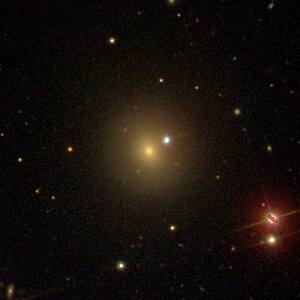NGC 2800
| Galaxy NGC 2800 |
|
|---|---|

|
|
| SDSS recording | |
| AladinLite | |
| Constellation | cancer |
|
Position equinox : J2000.0 , epoch : J2000.0 |
|
| Right ascension | 09 h 18 m 35.2 s |
| declination | + 52 ° 30 ′ 52 ″ |
| Appearance | |
| Morphological type | E. |
| Brightness (visual) | 12.8 mag |
| Brightness (B-band) | 13.8 mag |
| Angular expansion | 1.4 ′ × 0.9 ′ |
| Position angle | 15 ° |
| Surface brightness | 13.1 mag / arcmin² |
| Physical data | |
| Redshift | 0.025424 +/- 0.000103 |
| Radial velocity | 7622 +/- 31 km / s |
|
Stroke distance v rad / H 0 |
(342 ± 24) x 10 6 ly (105.0 ± 7.4) Mpc |
| history | |
| discovery | William Herschel |
| Discovery date | March 17, 1790 |
| Catalog names | |
| NGC 2800 • UGC 4920 • PGC 26302 • MCG + 09-15-117 • 2MASX J09183516 + 5230524 • GC 1789 • H III 832 • h 574 • | |
NGC 2800 is an elliptical galaxy of Hubble type E in the constellation Bigger Bear at the northern sky , the 342 million light-years from an estimated Milky Way is removed.
The object was discovered on March 17, 1790 by the astronomer William Herschel with a 48 cm telescope.
